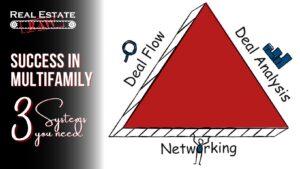The comparable sales approach to valuing a multifamily asset considers the comparable sales (comps) in the area. You will look at what other people have paid for similar properties in the area and use that to find the market value of your property. When you look at the sale of properties in a market to decide its value, you need to know if you are looking at a comparable property or not.
The following will help you to make sure that the information you have been given (probably by a realtor) is reliable. I am not saying that anyone would directly misrepresent data but only showing “certain” properties and leaving others out could skew the market image.
Note-
Creative financing for multifamily does not escape this conversation either. Just because a seller is willing to give or accept a seller or creative financing deal does not mean that you should not treat it just like a regular deal when doing your analysis. You should!
Consider the following when looking at comparable sales data in a market:
- Distance: Apartments need to be in the same sub-market (three- to five-mile radius around your subject property).
- Age: The comps should be built within five to ten years of your property.
- Size: Houses should be the same bed/bath and square footage. Apartments should be the same bed/bath and square footage of each unit type, but the total number of units should also be roughly the same. You would not compare a 10-unit complex with a 150-unit complex.
- Amenities: You should look to see if the competing complexes have more or better amenities than your property. Make sure your property is close to the comps in amenities such as a pool or laundry facility. In newer properties, you need to look at things like a recreational facility or a business center. Are others offering free cable or Wi-Fi and you are not? This makes a big difference in total property value.
A formal appraisal from a licensed appraiser is the only way to be sure of a property’s value. You will likely have to do an appraisal before you get a traditional loan, but you may not when dealing with creative financing for multifamily or any type of real estate.
If you find that a property passes your valuation, then you would want to pay for the actual appraisal, but not before you do your own homework on the property. The income approach will help you to decide if the deal will make money or not. The comparable sale approach will help you to place the deal into the surrounding market as far as value is concerned. You should use both.
Need help with getting reliable multifamily deal flow? Check out my article on the subject.
How to Avoid Mistakes with the Comparable Sales Approach
The following are a few other ways to avoid mistakes when analyzing deals…
Know Your Market
When you begin valuing a deal, you will want to look very closely at the market that surrounds your property. As you have seen from my mistake, you can lose big if you don’t know your market. I was only okay because I bought for cash flow, not for sale value. If I were betting on selling at a profit, I would have gone into foreclosure with that deal.
Understand Occupancy
Know the average occupancy of comparable properties in your area. If you look at an apartment deal and see that the occupancy is 70% and you will cash flow at 85%, getting those units rented is a value play for this deal. If you look in a three- to five-mile radius and all the properties in the area are at 70% occupancy, then this is not a value play at all: it’s the market! Remember: You can rehab a property, but you cannot rehab a market.
As interest rates increase you will also see more deals being directly offered with seller financing or some form of creative financing. Look for properties where you can increase occupancy in a short amount of time by improving operations. This type of deal is a great fit for a master lease option.
Know your competition.
It is not enough to look at a property with two-bed units and then look at the other properties with two-bed units and compare the rents. They may be charging more for a two-bed unit than you are, but if they have bigger units, then moving the rent up is not a value play. It will cause you to be less competitive in the area. Compare price per square foot (total rentable square feet divided by the rent) to make sure you are competitive with your rents.
Know the competitions amenities.
The more you have, the higher you can charge for rent. Make sure that when you are comparing rents, you also consider the value of your competitor’s amenities. If they have a pool and you don’t, they will get more in rent for a similarly sized unit.
Using the comparable sales approach for multifamily is just one method of asset valuation. You need to include the income approach as well. Both combined give you a full picture of an asset valuation. Use both approaches when negotiating seller or creative financing as well.
For more information like this check out the free resources available at https://realestateraw.com/blog/.
Best of luck!
Bill Ham


































